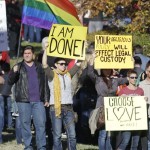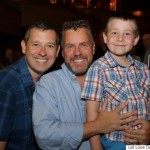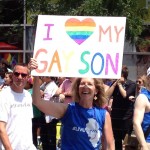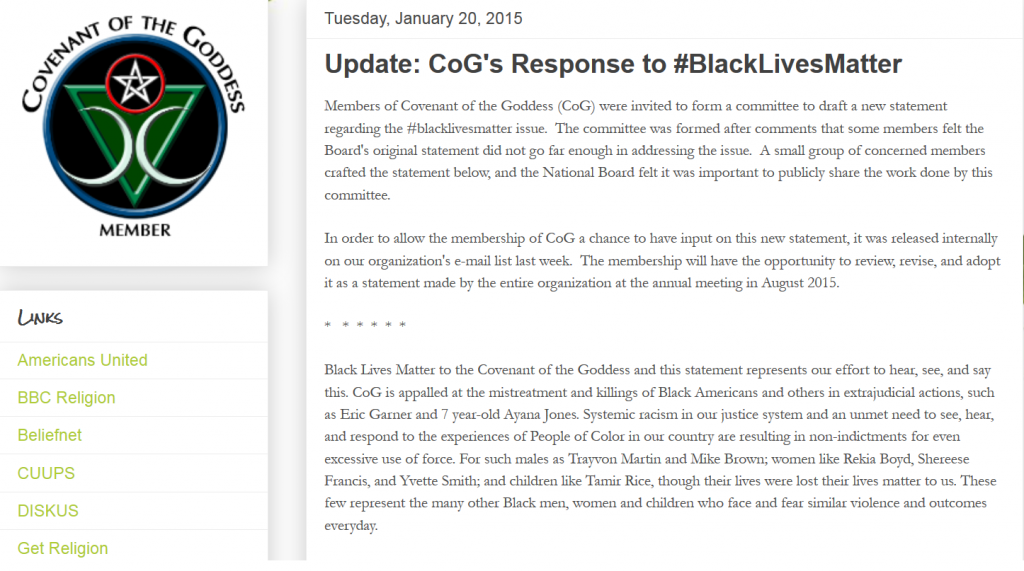I don’t often write about Mormonism here, and when I do it’s usually as a leaping off point to talk about Paganism or Jungianism. For those of you who don’t know, I was raised Mormon and left the Mormon Church formally by having my name withdrawn from the Church roles in 2001. I now infrequently attend the Mormon Church with my wife and kids, which often results in my posting something using Mormonism as a foil. This past weekend, my wife and I spend the weekend at a small Sunstone conference in Kirtland, Ohio, the site of several important landmarks in Mormon history. And it was such a positive and profound experience, I have to share it.
Mormons have an annoying saying about apostates and those who leave the Mormon church. They say, “The leave the Church, but they can’t leave the Church alone.” I find this statement annoying because it reflects an ignorance about the pain that the Church causes, a pain which those who chose to leave it may still feel acutely. The statement itself is really a function of the Mormon desire to return to blissful ignorance. Apostates are an unwelcome reminder that all is not well in Zion. Since nothing can be wrong with the Church, someone must be wrong with the people who leave it. As Richard and Joan Ostling write in Mormon America: The Power and the Promise (2007):
“The thin-skinned and image-conscious Mormon can display immature, isolationist, and defensive reactions to outsiders, perhaps because there is no substantive debate and no ‘loyal opposition’ within their kingdom. With some, it almost seems that the wilderness is still untamed, the federal ‘polyg’ police are on the prowl, and the Illinois lynch mob is still oiling muskets and preparing to raid Carthage Jail. All too often Saints use the label ‘anti-Mormon’ as a tactic to forestall serious discussion.”
To be fair, the statement is also a reaction to some really aggressive anti-Mormon propaganda which the Mormons have endured over the decades. Some really nasty stuff that the Mormon Church does not deserve. Having said that, not every former Mormon is “anti-Mormon” and not every cogent criticism of the Church’s doctrines, policies, and practices is truly “anti-Mormon”. There are some people who exist on the margins of the Mormon Church who remain faithful to it, hoping to reform it from within. Some recent baby steps the Mormon church has taken toward greater inclusiveness and honesty suggest that these efforts might even be somewhat effective. These include minor changes to the LDS scriptures, the most significant being in reference to the 1978 grant of the priesthood to the Black males; permitting women to pray in the LDS General Conference for the first time ever, and the semi-official apology given by a Mormon General Authority to representatives of the Mormon LGBT community for the pain caused by Prop 8. Like I said, baby steps.
The Sunstone conference was held in Kirtland, OH this past weekend. It is a (much) smaller version of the Sunstone Symposium. The Sunstone Symposium is a gathering of (mostly) liberal and (mostly) faithful Mormons (and members of the Community of Christ, formerly known as the Reorganized Church of Jesus Christ of Latter-day Saints). When I was a member, I only heard of Sunstone spoken of in whispers like it was a coven of Satanists. The Church had previously officially condemned independent symposia like Sunstone. When I finally went for the first time, I discovered a community of faithful LDS dissenters that I had never known existed. My wife and I attended to be part of a panel discussion about couples who survive one partner leaving the Church. The panel was later published in the Sunstone magazine and you can read the article here. I discovered that the Sunstone community consists of people who love the LDS Church, its history, and its people, and who want to see it become better. Honestly, had I known this community existed, or rather, if I had known of the size and vibrancy of this community, I may have remained a member of the Church longer. And really, I had no excuse for not knowing of its existence. Already before I left the Church, I had discovered the Sunstone Magazine and, especially, Dialogue, a Journal of Mormon Thought. I even have a brother-in-law who works in the independent Mormon publishing industry. But as it was, the final straw for me was when a Mormon General Authority made a statement to the effect that there are no loyal dissenters in the Mormon Church, effectively denying the reality of Sunstone. Honestly, I was just waiting for that straw to drop. The rest was just me gathering up my courage to do the inevitable.
Anyway, my wife and I attended the Conference primarily to hear Jennifer Finlayson-Fife and Natasha Helfer Parker give a workshop on faith transitions and LDS relationships. My wife is a marriage and family therapist, aspiring sex-therapist, and (obviously) wife of a post-Mormon Pagan, so this was right up our alley. Natasha is also a family and sex therapist, and is The Mormon Therapist over at Patheos, most well known for the stance she recently took on masturbation. Jennifer is a sex therapist who works close to where we live and who counsels patients experiencing faith transitions. Natasha and Jennifer recently were the guests of a great podcast on cognitive dissonance and faith transitions at the Mormon Mental Health Podcast and Mormon Stories Podcast. It was a great workshop, and I’m going to be writing more about it in a future post, because it deserves its own separate treatment.
Other highlights of the Conference included a panel discussion of dual-faith Mormons, which included Latter-day Saints (all prominent Sunstoners) who also attend Episcopalian, Catholic, Baptist, and Unitarian churches — all for different reasons, but many of them having to do with aesthetics, music, and liturgy. Two of the members of the panel were a gay couple who were united by their LDS identity, but split by their “bi-religiosity”. My wife could have been on that panel as well — and for that matter, so could my kids. It was a great discussion and very encouraging. I was very glad my 14-year old son was attending that session as well.
There was also a panel about the Mormon disconnect with Easter (and to a lesser extent Christmas). I experienced this disconnect myself this past month. I attended the sacrament service at the Mormon church and then drove over to catch the Unitarian service. There was only one reference to Easter in the Mormon service, and it was the bishop making the point that every Sunday is Easter for Mormons. It wasn’t until the Unitarian service that that it actually felt like Easter, which is ironic, since the vast majority in attendance were not Christian. I didn’t attend the panel on Mormons and Easter at the Conference, but I am really hoping to get a recording.
And we also attended a presentation by an Evangelical contrasting Paul’s conversion experience with Joseph Smith’s “First Vision”, the foundation experience of the Mormon “Restoration” (which I’ve blogged about here). It was a little “apples and oranges”, but it was interesting to see how Joseph Smith’s account of his First Vision evolved to match his evolving theology.
But the real highlight of the Conference was the closing plenary session, which actually took place in the main hall of the Kirtland Temple. I won’t bore you with the full history of the temple, but suffice it to say that it is a very unique building, built in the 1830s, and considered by Mormons to be one of the holiest places on earth. The Temple is actually owned by the Community of Christ (much to the chagrin of many Mormons), which is why we were able to have the plenary session there. The session began and ended with prayers to God the Mother and God the Father, a fact which my wife pointed out (to my pleasure) to my 10-year old daughter and my 14-year old son. (Mormons acknowledge the existence of Heavenly Mother, but do not speak to her, much less pray to her.) The highlight of the closing session was a talk given by LDS former Bishop Kevin Kloosterman about his journey toward being an LGBT advocate. Kevin was extremely humble and emotional throughout his talk. His story is one of a man who was at first indifferent to the suffering of LGBT Mormons, who gradually became aware of the terrible burden carried by LGBTs (of all faiths and none), and then, almost accidentally (I would say providentially), became an LGBT advocate. He even received a death threat at one point. You can see an earlier talk of Kevin’s here. I was so moved, I found myself singing the opening and closing hymns, “I Need Thee Every Hour” and “The Spirit of God”, with fervor, regardless of my doctrinal disagreements with the literal meaning of the text.
I tried to impress upon my children the meaning of this event, but for them it’s probably par for the course. But if you had told me 10 years ago that I would have been sitting in the Kirtland Temple praying to Heavenly Mother and listening to a talk on LGBT rights, I would have laughed at you. Admittedly, there were only about two dozen people there — hardly a groundswell — but the Mormon Church itself began with only a handful of people. And for every person in attendance, I know there are hundreds or even thousands with like sympathies. I was honored to be there, and I want to thank the Conference organizers for this wonderful event.
The following morning, my family and I attended church at the Community of Christ. It was a pleasure to hear a sermon which incorporated both Mormon scripture and the ideas of Dietrich Bonhoeffer (Mormons typically avoid including any “outside” not-officially sanctioned sources in their religious studies and Sunday services) and delivered by someone with an acute sense of social injustice paired with a sense of divine grace. We had the fortune of attending the same day that there were two baptisms, and, drawing on Bonhoeffer, the speaker described the act of baptism not as a cleansing of sins, as “an immersion in the world.” That is a concept I can get behind as a Pagan, and it is precisely what informed the ritual baptism which I wrote for my own children (and blogged about here). It was also a relief to hear the speaker condemn the religious exclusivist discourse which plagued the Community of Christ and still plagues the Mormon Church.
We then took the historical tour of the Kirtland Temple (conducted by the Community of Christ representatives) and other Mormon historical sites (conducted by Mormon representatives). Suffice it to say that the contrast between the tours revealed some subtle differences between the respective paradigms of the two churches, and the LDS tour left me longing for the more ambiguity-tolerant atmosphere of the Community of Christ.
There is more that I could write about, but I will leave it at this: Since my son identifies as Mormon and my wife will always be Mormon at heart, there will never be a time that I can foresee when I can “leave the Church alone”. I’m like a divorced parent, who must still co-parent with his ex-spouse. But as long as there are people like the ones I met this past weekend, I will be glad to remain on the fringes of the Mormon community — as a Mormon-friendly Pagan.















